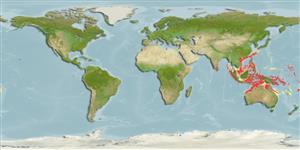Common names from other countries
>
Perciformes/Serranoidei (Groupers) >
Epinephelidae (Groupers)
Etymology: Epinephelus: Greek, epinephelos = cloudy (Ref. 45335); kupangensis: Name from Latin suffix '-ensis', denoting place or locality, is appended to the locality of Kupang, Indonesia, the center of the Timor Sea fishery that provided the first author with the holotype and several paratypes..
Environment: milieu / climate zone / depth range / distribution range
ນິເວດວິທະຍາ
ສັດທະເລ ກ່ຽວກັນຫີນ; ລະດັບຄວາມເລິກ 50 - 300 m (Ref. 111063). Tropical
Indo-West Pacific: Indonesia (Timor Sea), Timor-Leste, Philippines, Taiwan, and Fiji.
ຂະໜາດ / ນ້ຳໜັກ / Age
Maturity: Lm ? range ? - ? cm
Max length : 39.1 cm SL ຕົວຜູ້/ບໍ່ມີເພດ; (Ref. 111063)
Short description
ຕົວທີ່ໃຊ້ໃນການຈຳແນກຊະນິດ | ສະລີລະວິທະຍາ | ການວັດແທກຮູບຮ່າງລັກສະນະພາຍນອກຂອງດິນ,ສັດ,ປາ…
ຄີ (ໜາມ)ແຂງຢູ່ຫຼັງປາ (ທັງໝົດ) : 11; ຄີຫຼັງຂອງປາ (ຄີອ່ອນ) (ທັງໝົດ) : 15 - 17; ຄີ(ໜາມ) ແຂງຢູ່ຄີກົ້ນປາ
ກຸ່ມປາກະດູກແຂງ
ຄວາມຖີ່ຂອງກຸ່ມຖ່າຍທອດພັນ
ປາທີ່ມີການເຄື່ອນຍ້າຍຈາກທະເລໄປຫານ້ຳຈືດ ແລະນ້ຳຈືດຫາທະເລ
ປາທີ່ມີການເຄື່ອນຍ້າຍຈາກທະເລແລະໄປໄຂ່ຢູ່ນ້ຳຈືດ
ຄີກົ້ນຂອງປາ
ສັດທີ່ມີກະດູກສັນຫັຼງ
ການຖ່າຍທອດທາງກຳມະພັນຈາກພໍ່ແມ່ຫາລູກ: 3; ຄີກົ້ນຂອງປາ: 8. This species is distinguished from its Indo-Pacific congeners by having the following characters: lateral line scales 46-49 (vs. at least 51 in all species except E. areolatus, E.
bilobatus, E. bleekeri, E. bontoides, E. chlorostigma, E. faveatus, E. howlandi, E. longispinis, E. macrospilos, E. maculatus, E. merra, E. miliaris, E. polyphekadion, E. quoyanus, E. timorensis, E. trimaculatus), round caudal fin (vs. emarginate to truncate caudal fin in E. areolatus, E. bleekeri, E. chlorostigma, E. geoffroyi, E. timorensis), no distinct spots over most of head and body (vs. numerous distinct spots - not dots - over most of head and body in E. bilobatus, E. bontoides, E. faveatus, E. howlandi, E. longispinis, E. macrospilos, E. maculatus, E. merra, E. miliaris, E. polyphekadion, E. quoyanus, E. trimaculatus) (Ref. 111063).
This fish is part of a large, deep-water drop line fishery, which focuses its efforts on banks and promontories of shelf habitat in depths of up to 350 m (Ref. 111063).
Life cycle and mating behavior
Maturities | ການສືບພັນ | Spawnings | Egg(s) | Fecundities | ຕົວອ່ອນ
Tucker, S.J., E.M. Kurniasih and M.T. Craig, 2016. A new species of grouper (Epinephelus; Epinephelidae) from the Indo-Pacific. Copeia 104(3):658-662. (Ref. 111063)
IUCN Red List Status (Ref. 130435)
CITES (Ref. 128078)
Not Evaluated
Threat to humans
Harmless
Human uses
ເຄື່ອງມື
Special reports
Download XML
ແຫຼ່ງອີນເຕີເນັດ
Estimates based on models
Phylogenetic diversity index (Ref.
82804): PD
50 = 0.5000 [Uniqueness, from 0.5 = low to 2.0 = high].
Bayesian length-weight: a=0.01175 (0.00571 - 0.02419), b=3.04 (2.88 - 3.20), in cm Total Length, based on LWR estimates for this Genus-body shape (Ref.
93245).
ຊັ້ນເຂດຮ້ອນ (Ref.
69278): 3.8 ±0.6 se; based on size and trophs of closest relatives
ຄວາມຢືດຢຸ່ນ (Ref.
120179): ຂະໜາດກາງ, ປະຊາກອນຕຳ່ສຸດທີ່ໃຊ້ເວລາສອງເທົ່າ 1.4 - 4.4 ປີ (Preliminary K or Fecundity.).
Fishing Vulnerability (Ref.
59153): Moderate vulnerability (38 of 100).
